Content for TS 37.483 Word version: 17.3.0
8.2 Interface Management procedures
8.2.1 Reset
8.2.2 Error Indication
8.2.3 gNB-CU-UP E1 Setup
8.2.4 gNB-CU-CP E1 Setup
...
...
8.2 Interface Management procedures p. 20
8.2.1 Reset p. 20
8.2.1.1 General p. 20
The purpose of the Reset procedure is to initialise or re-initialise the E1AP UE-related contexts, in the event of a failure in the gNB-CU-CP or gNB-CU-UP. This procedure does not affect the application level configuration data exchanged during, e.g., the E1 Setup procedure.
The procedure uses non-UE associated signalling.
8.2.1.2 Successful Operation p. 21
8.2.1.2.1 Reset Procedure Initiated from the gNB-CU-CP p. 21
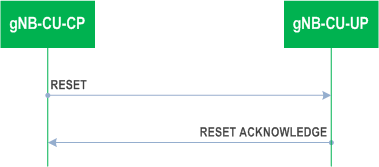
In the event of a failure at the gNB-CU-CP, which has resulted in the loss of some or all transaction reference information, a RESET message shall be sent to the gNB-CU-UP.
At reception of the RESET message the gNB-CU-UP shall release all allocated resources on E1 related to the UE association(s) indicated explicitly or implicitly in the RESET message and remove the indicated bearer contexts including E1AP ID.
After the gNB-CU-UP has released all assigned E1 resources and the UE E1AP IDs for all indicated UE associations which can be used for new UE-associated logical E1-connections over the E1 interface, the gNB-CU-UP shall respond with the RESET ACKNOWLEDGE message. The gNB-CU-UP does not need to wait for the release of bearer resources to be completed before returning the RESET ACKNOWLEDGE message.
If the RESET message contains the UE-associated logical E1-connection list IE, then:
If the RESET message is received, any other ongoing procedure (except for another Reset procedure) on the same E1 interface related to a UE association, indicated explicitly or implicitly in the RESET message, shall be aborted.
- The gNB-CU-UP shall use the gNB-CU-CP UE E1AP ID IE and/or the gNB-CU-UP UE E1AP ID IE to explicitly identify the UE association(s) to be reset.
- The gNB-CU-UP shall include in the RESET ACKNOWLEDGE message, for each UE association to be reset, the UE-associated logical E1-connection Item IE in the UE-associated logical E1-connection list IE. The UE-associated logical E1-connection Item IEs shall be in the same order as received in the RESET message and shall include also unknown UE-associated logical E1-connections. Empty UE-associated logical E1-connection Item IEs, received in the RESET message, may be omitted in the RESET ACKNOWLEDGE message.
- If the gNB-CU-CP UE E1AP ID IE is included in the UE-associated logical E1-connection Item IE for a UE association, the gNB-CU-UP shall include the gNB-CU-CP UE E1AP ID IE in the corresponding UE-associated logical E1-connection Item IE in the RESET ACKNOWLEDGE message.
- If the gNB-CU-UP UE E1AP ID IE is included in the UE-associated logical E1-connection Item IE for a UE association, the gNB-CU-UP shall include the gNB-CU-UP UE E1AP ID IE in the corresponding UE-associated logical E1-connection Item IE in the RESET ACKNOWLEDGE message.
8.2.1.2.2 Reset Procedure Initiated from the gNB-CU-UP p. 22
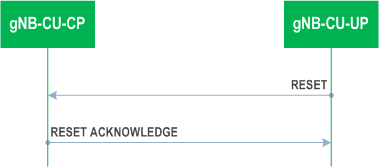
In the event of a failure at the gNB-CU-UP, which has resulted in the loss of some or all transaction reference information, a RESET message shall be sent to the gNB-CU-CP.
At reception of the RESET message the gNB-CU-CP shall release all allocated resources on E1 related to the UE association(s) indicated explicitly or implicitly in the RESET message and remove the E1AP ID for the indicated UE associations.
After the gNB-CU-CP has released all assigned E1 resources and the UE E1AP IDs for all indicated UE associations which can be used for new UE-associated logical E1-connections over the E1 interface, the gNB-CU-CP shall respond with the RESET ACKNOWLEDGE message. The gNB-CU-CP does not need to wait for the release of bearer resources to be completed before returning the RESET ACKNOWLEDGE message.
If the RESET message contains the UE-associated logical E1-connection list IE, then:
If the RESET message is received, any other ongoing procedure (except for another Reset procedure) on the same E1 interface related to a UE association, indicated explicitly or implicitly in the RESET message, shall be aborted.
- The gNB-CU-CP shall use the gNB-CU-CP UE E1AP ID IE and/or the gNB-CU-UP UE E1AP ID IE to explicitly identify the UE association(s) to be reset.
- The gNB-CU-CP shall in the RESET ACKNOWLEDGE message include, for each UE association to be reset, the UE-associated logical E1-connection Item IE in the UE-associated logical E1-connection list IE. The UE-associated logical E1-connection Item IEs shall be in the same order as received in the RESET message and shall include also unknown UE-associated logical E1-connections. Empty UE-associated logical E1-connection Item IEs, received in the RESET message, may be omitted in the RESET ACKNOWLEDGE message.
- If the gNB-CU-CP UE E1AP ID IE is included in the UE-associated logical E1-connection Item IE for a UE association, the gNB-CU-CP shall include the gNB-CU-CP UE E1AP ID IE in the corresponding UE-associated logical E1-connection Item IE in the RESET ACKNOWLEDGE message.
- If the gNB-CU-UP UE E1AP ID IE is included in a UE-associated logical E1-connection Item IE for a UE association, the gNB-CU-CP shall include the gNB-CU-UP UE E1AP ID IE in the corresponding UE-associated logical E1-connection Item IE in the RESET ACKNOWLEDGE message.
8.2.1.3 Abnormal Conditions p. 22
Not applicable.
8.2.2 Error Indication p. 23
8.2.2.1 General p. 23
The Error Indication procedure is initiated by a node in order to report detected errors in one incoming message, provided they cannot be reported by an appropriate failure message.
If the error situation arises due to reception of a message utilising UE associated signalling, then the Error Indication procedure uses UE associated signalling. Otherwise the procedure uses non-UE associated signalling.
8.2.2.2 Successful Operation p. 23


When the conditions defined in clause 10 are fulfilled, the Error Indication procedure is initiated by an ERROR INDICATION message sent from the receiving node.
The ERROR INDICATION message shall contain at least either the Cause IE or the Criticality Diagnostics IE. In case the Error Indication procedure is triggered by utilising UE associated signalling the gNB-CU-CP UE E1AP ID IE and gNB-CU-UP UE E1AP ID IE shall be included in the ERROR INDICATION message. If one or both of the gNB-CU-CP UE E1AP ID IE and the gNB-CU-UP UE E1AP ID IE are not correct, the cause shall be set to appropriate value, e.g., "Unknown or already allocated gNB-CU-CP UE E1AP ID", "Unknown or already allocated gNB-CU-UP UE E1AP ID" or "Unknown or inconsistent pair of UE E1AP ID".
8.2.2.3 Abnormal Conditions p. 23
Not applicable.
8.2.3 gNB-CU-UP E1 Setup p. 24
8.2.3.1 General p. 24
The purpose of the gNB-CU-UP E1 Setup procedure is to exchange application level data needed for the gNB-CU-UP and the gNB-CU-CP to correctly interoperate on the E1 interface. If the gNB-CU-UP initiates the first TNL association, it shall also initiate the gNB-CU-UP E1 Setup procedure. The procedure uses non-UE associated signalling.
This procedure erases any existing application level configuration data in the two nodes and replaces it by the one received. This procedure also re-initialises the E1AP UE-related contexts (if any) and erases all related signalling connections in the two nodes like a Reset procedure would do.
8.2.3.2 Successful Operation p. 24
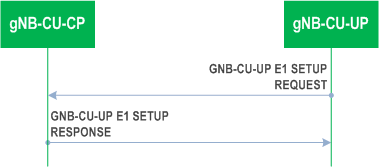
The gNB-CU-UP initiates the procedure by sending a GNB-CU-UP E1 SETUP REQUEST message including the appropriate data to the gNB-CU-CP. The gNB-CU-CP responds with a GNB-CU-UP E1 SETUP RESPONSE message including the appropriate data.
If the GNB-CU-UP E1 SETUP REQUEST message contains the gNB-CU-UP Name IE the gNB-CU-CP may use this IE as a human readable name of the gNB-CU-UP. If the GNB-CU-UP E1 SETUP REQUEST message contains the Extended gNB-CU-UP Name IE, the gNB-CU-CP may use this IE as a human readable name of the gNB-CU-UP and shall ignore the gNB-CU-UP Name IE if included.
If the GNB-CU-UP E1 SETUP RESPONSE message contains the gNB-CU-CP Name IE, the gNB-CU-UP may use this IE as a human readable name of the gNB-CU-CP. If the GNB-CU-UP E1 SETUP RESPONSE message contains the Extended gNB-CU-CP Name IE, the GNB-CU-UP may use this IE as a human readable name of the gNB-CU-CP and shall ignore the gNB-CU-CP Name IE if included.
If the Slice Support List IE is contained in the GNB-CU-UP E1 SETUP REQUEST message, the gNB-CU-CP shall store the corresponding information and it may take it into account for bearer context establishment.
If the NR CGI Support List or the Extended NR CGI Support List IE is contained in the GNB-CU-UP E1 SETUP REQUEST message, the gNB-CU-CP shall store the corresponding information and it may take it into account for bearer context establishment.
If the ECGI Support List IE is contained in the GNB-CU-UP E1 SETUP REQUEST message, the gNB-CU-CP shall store the corresponding information and it may take it into account for bearer context establishment.
If the QoS Parameters Support List IE is contained in the GNB-CU-UP E1 SETUP REQUEST message, the gNB-CU-CP shall store the corresponding information and it may take it into account for bearer context establishment.
If the NPN Support Information IE is contained in the GNB-CU-UP E1 SETUP REQUEST message, the gNB-CU-CP shall store the corresponding information and it may take it into account for bearer context establishment.
The exchanged data shall be stored in respective node and used as long as there is an operational TNL association. When this procedure is finished, the E1 interface is operational and other E1 messages can be exchanged.
If the gNB-CU-UP Capacity IE is contained in the GNB-CU-UP E1 SETUP REQUEST message, the gNB-CU-CP shall take this IE into account.
If the GNB-CU-UP E1 SETUP REQUEST message includes the Transport Network Layer Address Info IE, the gNB-CU-CP shall, if supported, take this IE into account for IPSec tunnel establishment.
If the GNB-CU-UP E1 SETUP RESPONSE message includes the Transport Network Layer Address Info IE, the gNB-CU-UP shall, if supported, take this IE into account for IPSec tunnel establishment.
8.2.3.3 Unsuccessful Operation p. 25
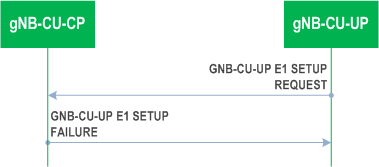
If the gNB-CU-CP cannot accept the setup, it shall respond with a GNB-CU-UP E1 SETUP FAILURE and appropriate cause value.
If the GNB-CU-UP E1 SETUP FAILURE message includes the Time To Wait IE, the gNB-CU-UP shall wait at least for the indicated time before reinitiating the E1 setup towards the same gNB-CU-CP.
8.2.3.4 Abnormal Conditions p. 25
If the first message received for a specific TNL association is not a GNB-CU-CP E1 SETUP REQUEST, GNB-CU-UP E1 SETUP RESPONSE, or GNB-CU-UP E1 SETUP FAILURE message then this shall be treated as a logical error.
If the gNB-CU-UP does not receive either GNB-CU-UP E1 SETUP RESPONSE message or GNB-CU-UP E1 SETUP FAILURE message, the gNB-CU-UP may reinitiate the gNB-CU-UP E1 Setup procedure towards the same gNB-CU-CP, provided that the content of the new GNB-CU-UP E1 SETUP REQUEST message is identical to the content of the previously unacknowledged GNB-CU-UP E1 SETUP REQUEST message.
If the gNB-CU-UP receives a GNB-CU-CP E1 SETUP REQUEST message from the peer entity on the same E1 interface:
- In case the gNB-CU-UP answers with a GNB-CU-CP E1 SETUP RESPONSE message and receives a subsequent GNB-CU-UP E1 SETUP FAILURE message, the gNB-CU-UP shall consider the E1 interface as non operational and the procedure as unsuccessfully terminated according to sub clause 8.2.3.3.
- In case the gNB-CU-UP answers with a GNB-CU-CP E1 SETUP FAILURE message and receives a subsequent GNB-CU-UP E1 SETUP RESPONSE message, the gNB-CU-UP shall ignore the GNB-CU-UP E1 SETUP RESPONSE message and consider the E1 interface as non operational.
8.2.4 gNB-CU-CP E1 Setup p. 25
8.2.4.1 General p. 25
The purpose of the gNB-CU-CP E1 Setup procedure is to exchange application level data needed for the gNB-CU-CP and the gNB-CU-UP to correctly interoperate on the E1 interface. If the gNB-CU-CP initiates the first TNL association, it shall also initiate the gNB-CU-CP E1 Setup procedure.The procedure uses non-UE associated signalling.
This procedure erases any existing application level configuration data in the two nodes and replaces it by the one received. This procedure also re-initialises the E1AP UE-related contexts (if any) and erases all related signalling connections in the two nodes like a Reset procedure would do.
8.2.4.2 Successful Operation p. 26
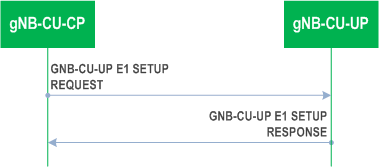
The gNB-CU-CP initiates the procedure by sending a GNB-CU-CP E1 SETUP REQUEST message including the appropriate data to the gNB-CU-UP. The gNB-CU-UP responds with a GNB-CU-CP E1 SETUP RESPONSE message including the appropriate data.
If the GNB-CU-CP E1 SETUP REQUEST message contains the gNB-CU-CP Name IE the gNB-CU-UP may use this IE as a human readable name of the gNB-CU-CP. If the GNB-CU-CP E1 SETUP REQUEST message contains the Extended gNB-CU-CP Name IE, the gNB-CU-UP may use this IE as a human readable name of the gNB-CU-CP and shall ignore the gNB-CU-CP Name IE if included.
If the GNB-CU-CP E1 SETUP RESPONSE message contains the gNB-CU-UP Name IE, the gNB-CU-CP may use this IE as a human readable name of the gNB-CU-UP. If the GNB-CU-CP E1 SETUP RESPONSE message contains the Extended gNB-CU-UP Name IE, the GNB-CU-CP may use this IE as a human readable name of the gNB-CU-UP and shall ignore the gNB-CU-UP Name IE if included.
The exchanged data shall be stored in respective node and used as long as there is an operational TNL association. When this procedure is finished, the E1 interface is operational and other E1 messages can be exchanged.
If the gNB-CU-UP Capacity IE is contained in the GNB-CU-CP E1 SETUP RESPONSE message, the gNB-CU-CP shall take this IE into account.
If the GNB-CU-CP E1 SETUP REQUEST message includes the Transport Network Layer Address Info IE, the gNB-CU-UP shall, if supported, take this IE into account for IPSec tunnel establishment.
If the GNB-CU-CP E1 SETUP RESPONSE message includes the Transport Network Layer Address Info IE, the gNB-CU-CP shall, if supported, take this IE into account for IPSec tunnel establishment.
If the NPN Support Information IE is contained in the GNB-CU-CP E1 SETUP RESPONSE message, the gNB-CU-CP shall store the corresponding information and it may take it into account for bearer context establishment.
If the NR CGI Support List or the Extended NR CGI Support List IE is contained in the GNB-CU-CP E1 SETUP RESPONSE message, the gNB-CU-CP shall store the corresponding information and it may take it into account for bearer context establishment.
If the ECGI Support List IE is contained in the GNB-CU-CP E1 SETUP RESPONSE message, the gNB-CU-CP shall store the corresponding information and it may take it into account for bearer context establishment.
8.2.4.3 Unsuccessful Operation p. 27
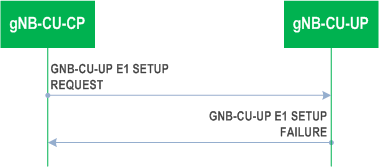
If the gNB-CU-UP cannot accept the setup, it shall respond with a GNB-CU-CP E1 SETUP FAILURE and appropriate cause value.
If the GNB-CU-CP E1 SETUP FAILURE message includes the Time To Wait IE, the gNB-CU-CP shall wait at least for the indicated time before reinitiating the E1 setup towards the same gNB-CU-UP.
8.2.4.4 Abnormal Conditions p. 27
If the first message received for a specific TNL association is not a GNB-CU-UP E1 SETUP REQUEST, GNB-CU-CP E1 SETUP RESPONSE, or GNB-CU-CP E1 SETUP FAILURE message then this shall be treated as a logical error.
If the gNB-CU-CP does not receive either GNB-CU-CP E1 SETUP RESPONSE message or GNB-CU-CP E1 SETUP FAILURE message, the gNB-CU-CP may reinitiate the gNB-CU-CP E1 Setup procedure towards the same gNB-CU-UP, provided that the content of the new GNB-CU-CP E1 SETUP REQUEST message is identical to the content of the previously unacknowledged GNB-CU-CP E1 SETUP REQUEST message.
If the gNB-CU-CP receives a GNB-CU-UP E1 SETUP REQUEST message from the peer entity on the same E1 interface:
- In case the gNB-CU-CP answers with a GNB-CU-UP E1 SETUP RESPONSE message and receives a subsequent GNB-CU-CP E1 SETUP FAILURE message, the gNB-CU-CP shall consider the E1 interface as non operational and the procedure as unsuccessfully terminated according to sub clause 8.2.4.3.
- In case the gNB-CU-CP answers with a GNB-CU-UP E1 SETUP FAILURE message and receives a subsequent GNB-CU-CP E1 SETUP RESPONSE message, the gNB-CU-CP shall ignore the GNB-CU-CP E1 SETUP RESPONSE message and consider the E1 interface as non operational.